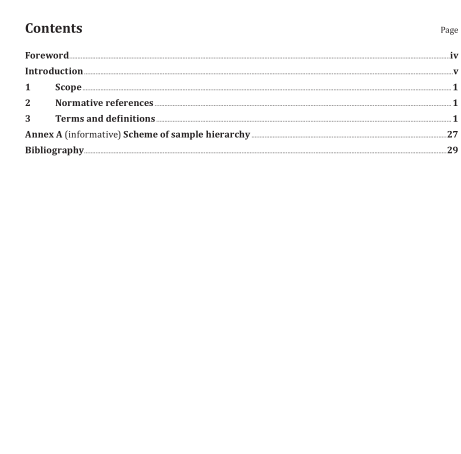ISO 16559:2022 pdf download.Solid biofuels — Vocabulary
This document establishes a vocabulary for solid biofuels. This document only includes raw and processed material originating from
— forestry and arboriculture,
— agriculture and horticulture, and
— aquaculture.
NOTE 1 Chemically treated material cannot include halogenated organic compounds or heavy metals at levels higher than those in typical virgin material values (see also ISO 17225-1:2021, Annex B) or higher than typical values of the country of origin.
NOTE 2 Raw and processed material includes woody, herbaceous, fruit and aquatic biomass and biodegradable waste originating from above sectors.
Materials originating from different recycling processes of end-of-life-products are outside the scope of this document but relevant terms are included for information. Liquid biofuels (ISO/TC 28/SC 7), natural gas (ISO/TC 193) and solid recovered fuels (ISO/TC 300) are outside the scope of this document.
2 Normative references
There are no normative references in this document.
3 Terms and definitions
For the purposes of this document, the following terms and definitions apply.
ISO and IEC maintain terminology databases for use in standardization at the following addresses:
— ISO Online browsing platform: available at https:// www .iso .org/ obp
— IEC Electropedia: available at https:// www .electropedia .org/
3.1 absorption
phenomenon whereby atoms, ions, or molecules from a gas, liquid, or dissolved solid permeates or is dissolved by a liquid or solid (the absorbent)
Note 1 to entry: Adsorption (3.3) is a surface-based process while absorption involves the whole volume (3.214) of the material.
3.2 additive
material which has been intentionally introduced into the fuel feedstock (3.86) to improve quality (3.160) of fuel (3.99) (e.g. combustion or durability properties), to reduce emissions or to make production more efficient
Note 1 to entry: Trace amounts of, e.g. grease or other lubricants that are introduced into the fuel (3.99) processing stream as part of typical mill operations are not considered as additives.
[SOURCE: ISO 17225-2:2021, 3.1]
3.11 as determined
as analysed
ad reference moisture content (3.132) of the material at the moment of analysis/determination
Note 1 to entry: “ad” is used as a subscript, e.g. M ad is equivalent to moisture content (3.132) at the time of determination.
3.12 as received
as delivered
ar calculation basis for a material in the delivery state Note 1 to entry: The abbreviation of as received is “ar”.
3.13 ash
ash content
total ash
A mass of inorganic residue remaining after complete combustion of a fuel (3.99) under specified conditions, typically expressed as a percentage of the mass of dry matter (3.71) in fuel (3.99)
Note 1 to entry: See also ash melting behaviour (3.17).
Note 2 to entry: Depending on the combustion efficiency, the ash can contain combustibles.
Note 3 to entry: If a complete combustion is realised, ash contains only inorganic, non-combustible components.
3.14 ash deformation temperature
deformation temperature
DT temperature at which first signs of melting occur
Note 1 to entry: See also ash melting behaviour (3.17).
Note 2 to entry: Ash deformation temperature can be seen as rounding of the edges, smoothing of surfaces, expansion of the cylinder or general changing of the cylinder shape. If the test piece starts to swell or bubble without the edges being rounded, the temperature is registered as DT (since swelling and bubbling only occur when a fraction of the ash (3.13) is melted).
[SOURCE: ISO 21404:2020, 3.2, modified — First preferred term added, Notes 1 and 3 to entry deleted, new Note 1 to entry added.]
3.15 ash flow temperature
flow temperature
FT temperature at which the ash (3.13) is spread out over the supporting tile in a layer, the height of which is half of the height of the test piece at the ash hemisphere temperature (3.16)
Note 1 to entry: See also ash melting behaviour (3.17).
3.16 ash hemisphere temperature
hemisphere temperature
HT temperature at which the test piece forms approximately a hemisphere, i.e. when the height is half of the base diameter
Note 1 to entry: See also ash melting behaviour (3.17).
[SOURCE: ISO 21404:2020, 3.3, modified — First preferred term added, Note to entry added.]ISO 16559 pdf download.ISO 16559 pdf download
